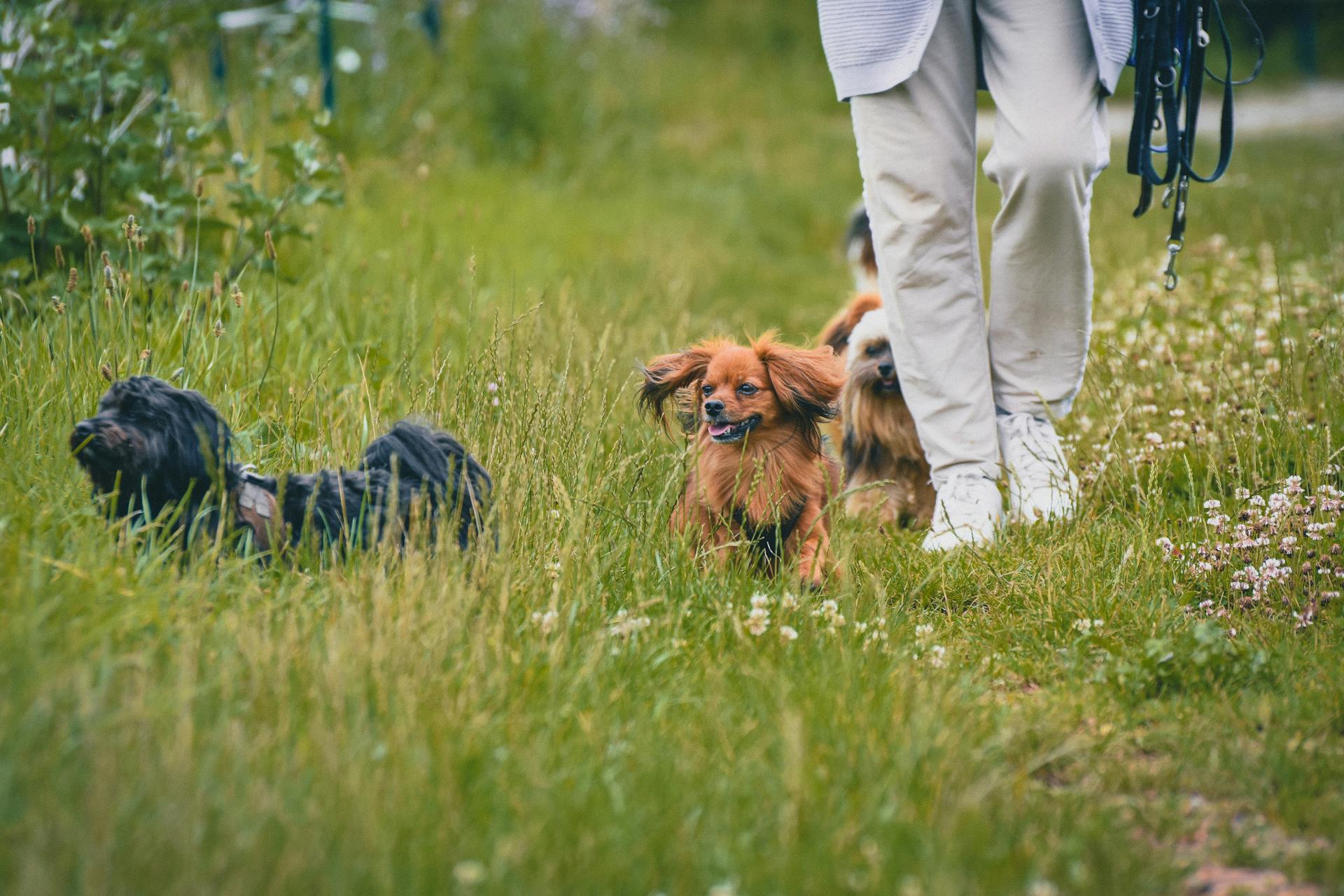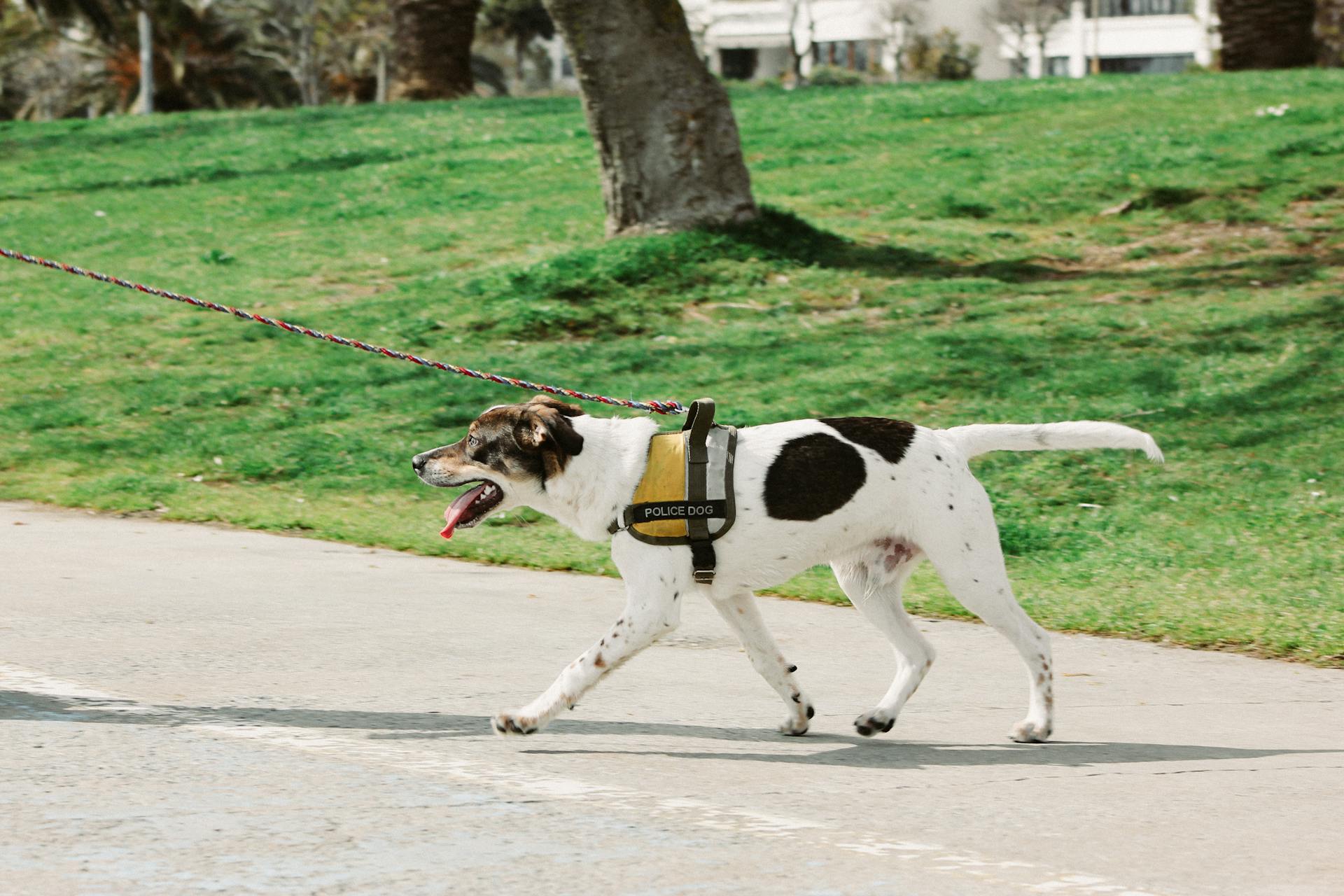
Walking your dog in poor air quality can be a real challenge.
Air pollution can exacerbate respiratory issues in dogs, just like it does in humans.
Dogs with pre-existing conditions like bronchitis or asthma should avoid walking in areas with high air pollution.
If you must walk your dog in poor air quality, consider shortening the walk or choosing a route with cleaner air.
Keeping Pets Safe
Limit your dog's walks to short ones to minimize exposure to poor air quality. Short-faced breeds like pugs and bulldogs are more sensitive to respiratory distress, so it's best to keep them indoors altogether.
Humid air and a cool temperature can help your dog breathe easier, so make sure to keep them comfortable while indoors. Clean water should always be available to your pet.
If you have a sensitive pet, consider investing in a HEPA filter to improve indoor air quality. This can be especially helpful during poor air quality alerts.
Here are some signs to look out for if your pet is experiencing smoke inhalation:
- Watery or irritated eyes
- Runny nose
- Coughing or wheezing
- Labored, rapid, or open-mouthed breathing
- Loss of coordination
- Lethargy
- Loss of appetite or thirst
If you notice any of these symptoms, contact your vet immediately.
Understanding Pet Health
Dogs can be sensitive to poor air quality, and it's essential to take steps to protect them. Short-faced breeds like pugs and bulldogs are particularly vulnerable to respiratory distress.
Limiting exposure to poor air quality is crucial, so keep walks short and consider using absorbent pads at home instead of taking your pet outside. This is especially important for sensitive pets.
Monitoring your pet's behavior is key to detecting signs of air quality issues. Look out for watery or irritated eyes, runny nose, coughing or wheezing, labored breathing, and loss of coordination. If you notice any of these symptoms, contact your vet immediately.
Poor air quality can cause a range of health problems in dogs, including respiratory disease and inflammation of the nose, throat, and eyes. Common sources of unhealthy air include wildfire smoke, ozone, vehicle exhaust, and cleaning chemicals.
To minimize your dog's exposure to poor air quality, check the outdoor air quality in your area using AirNow.gov and limit outdoor time on unhealthy days. You can also get creative with indoor exercise options, like using a treadmill or playing indoor fetch.
Here are some signs of air quality issues in dogs:
- Coughing or gagging
- Nasal discharge
- Difficulty breathing
- Eye irritation and excessive watering
- Throat or mouth inflammation
- Asthma-like reactions
- Increased breathing rate
- Disorientation or stumbling
- Reduced appetite or thirst
- Fatigue or weakness
If your dog is experiencing any of these symptoms, contact your vet straight away.
Protecting Your Pet
Limit outdoor time for your pet on days with unhealthy air quality, as vets recommend keeping walks short to prevent respiratory distress.
Short-faced breeds like pugs and bulldogs are especially sensitive to poor air quality, so it's best to keep them indoors altogether.
Monitor indoor air quality by keeping windows and doors closed, and consider investing in a HEPA filter, especially if your pet is sensitive.
Keep an eye out for signs of smoke inhalation, such as coughing, wheezing, and red, irritated eyes.
If your pet is showing any of the following symptoms, contact your vet immediately: watery or irritated eyes, runny nose, coughing or wheezing, labored breathing, loss of coordination, lethargy, loss of appetite or thirst.
Check the outdoor air quality in your area by visiting AirNow.gov and entering your zip code to plan walks accordingly.
Some common sources of unhealthy air include wildfire smoke, ozone, vehicle exhaust, and smog, so try to limit outdoor time near high-traffic areas.
Here are some simple steps to minimize your pet's exposure to poor indoor air quality:
- Keep windows and doors closed on days with unhealthy air quality;
- Change your HVAC filters regularly;
- Dust and vacuum often to reduce particle pollution;
- Wipe your pet's feet when they come indoors;
- Use an air purifier to help reduce indoor air pollution.
Exercise and Air Quality
Outdoor exercise can be a major contributor to increased respiratory distress in dogs during poor air quality.
Limiting walks to short periods can help reduce exposure to harmful air pollutants.
For short-faced breeds like pugs and bulldogs, it's best to avoid taking them outside altogether.
Keeping your dog on a leash can help you control their exposure and bring them back in quickly.
Dogs need access to clean water at all times, especially in dry air.
Humid air and keeping the temperature cool can also help prevent excessive panting in dogs.
How Poor Air Affects Pets
Poor air quality can have a significant impact on our furry friends. Pets can be allergic to pollen, mold spores, and other airborne particles, just like us.
Exposure to poor air quality can cause irritation to a pet's nose, throat, and eyes, leading to inflammation and redness. This can also lead to respiratory issues like coughing, fast breathing, or difficulty breathing.
Some pets are more susceptible to the negative effects of poor air quality, including puppies, senior dogs, and dogs with respiratory or heart disease. Breeds with shorter muzzles, such as Bulldogs, Boston Terriers, and Pugs, are also more vulnerable.
Common sources of unhealthy air include wildfire smoke, ozone, vehicle exhaust and smog, cleaning chemicals and other VOCs, pollen, and dust. Your pet probably won't be able to tell you when bad air quality is bothering them, so it's up to you to monitor indoor and outdoor air quality.
Here are some signs of negative health consequences from wildfire smoke inhalation that warrant contacting your vet straight away:
- Coughing or gagging
- Nasal discharge
- Difficulty breathing
- Eye irritation and excessive watering
- Throat or mouth inflammation
- Asthma-like reactions
- Increased breathing rate
- Disorientation or stumbling
- Reduced appetite or thirst
- Fatigue or weakness
Frequently Asked Questions
Is it OK to walk in unhealthy air quality?
No, it's not recommended to walk in unhealthy air quality. Consider moving your outdoor activities indoors when pollution levels are high
Sources
- https://www.today.com/health/news/how-to-keep-pets-safe-dangerous-air-quality-alerts-rcna88403
- https://wagwalking.com/daily/keeping-your-dog-safe-from-wildfire-smoke-and-poor-air-quality
- https://www.thestar.com/news/gta/bad-air-quality-is-dangerous-for-your-pets-here-s-how-to-protect-them-from/article_776dc3c4-7acc-5631-9321-146f8e4e528b.html
- https://www.dogster.com/lifestyle/does-air-quality-affect-dogs
- https://molekule.com/blogs/all/unhealthy-air-quality-and-pet-health
Featured Images: pexels.com


